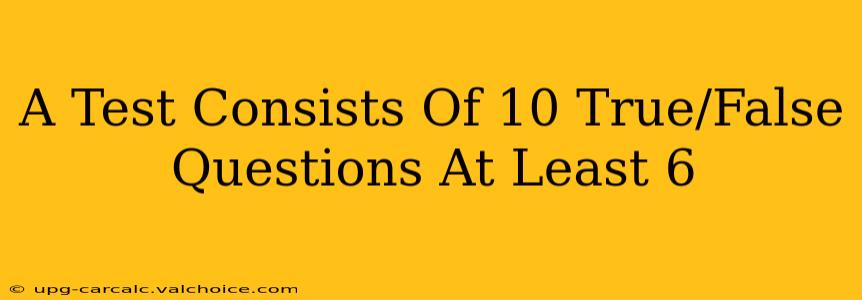A Test Consists of 10 True/False Questions: At Least 6 Correct for a Pass?
Passing a test hinges on several factors, but when that test involves 10 true/false questions and a passing grade requires at least 6 correct answers, the stakes become clear. This scenario presents a unique challenge, demanding both knowledge and a degree of strategic guessing. Let's delve into the probabilities, strategies, and the overall importance of understanding this type of assessment.
Understanding the Odds
With 10 true/false questions, there's a 50/50 chance of getting any single question right by pure guesswork. However, needing at least 6 correct answers significantly reduces the likelihood of passing purely by chance. We can use combinatorics to calculate the exact probabilities.
There are a total of 2¹⁰ (1024) possible combinations of answers. To calculate the number of ways to get at least 6 correct answers, we need to consider the number of ways to get 6, 7, 8, 9, and 10 correct answers individually and sum them up. This calculation requires a deeper dive into binomial probability or using statistical software.
Key takeaway: While a detailed calculation is beyond the scope of this article, it's important to understand that pure guessing significantly diminishes your chances of passing this test. Preparation and understanding the material are crucial.
Strategies for Success
So, how can you increase your chances of passing this test?
- Study the Material: This may seem obvious, but thorough preparation is the single most effective strategy. The more you understand the subject matter, the more likely you are to answer correctly.
- Process of Elimination: If you're unsure of an answer, try to eliminate incorrect options. Even if you can't determine the definitive answer, narrowing down the possibilities increases your chances of guessing correctly.
- Identify Patterns and Trends: Look for patterns or trends within the questions. Sometimes, questions are linked, and answering one might give you a clue about another.
- Manage Your Time: Don't rush. Read each question carefully and consider your answers thoughtfully. Effective time management minimizes careless errors.
- Review Your Answers: If time allows, review your answers before submitting the test. Look for any inconsistencies or questions you might have rushed through.
Beyond the Numbers: The Importance of Understanding Assessments
This 10 true/false question scenario highlights the importance of understanding the assessment methods used in various situations. Whether it's a school exam, a certification test, or a quiz, knowing the scoring system and the required performance level allows you to strategize effectively.
Beyond the specific numbers, the core message is preparation. Thorough studying significantly improves your chances of success, regardless of the test format.
Optimizing Your Approach for Similar Assessments
The principles discussed here—preparation, strategic guessing, and time management—apply broadly to many assessments. Understanding the structure and requirements of any test is crucial for optimizing your performance. Remember that even a small improvement in preparation can lead to a significant increase in your chances of success.

